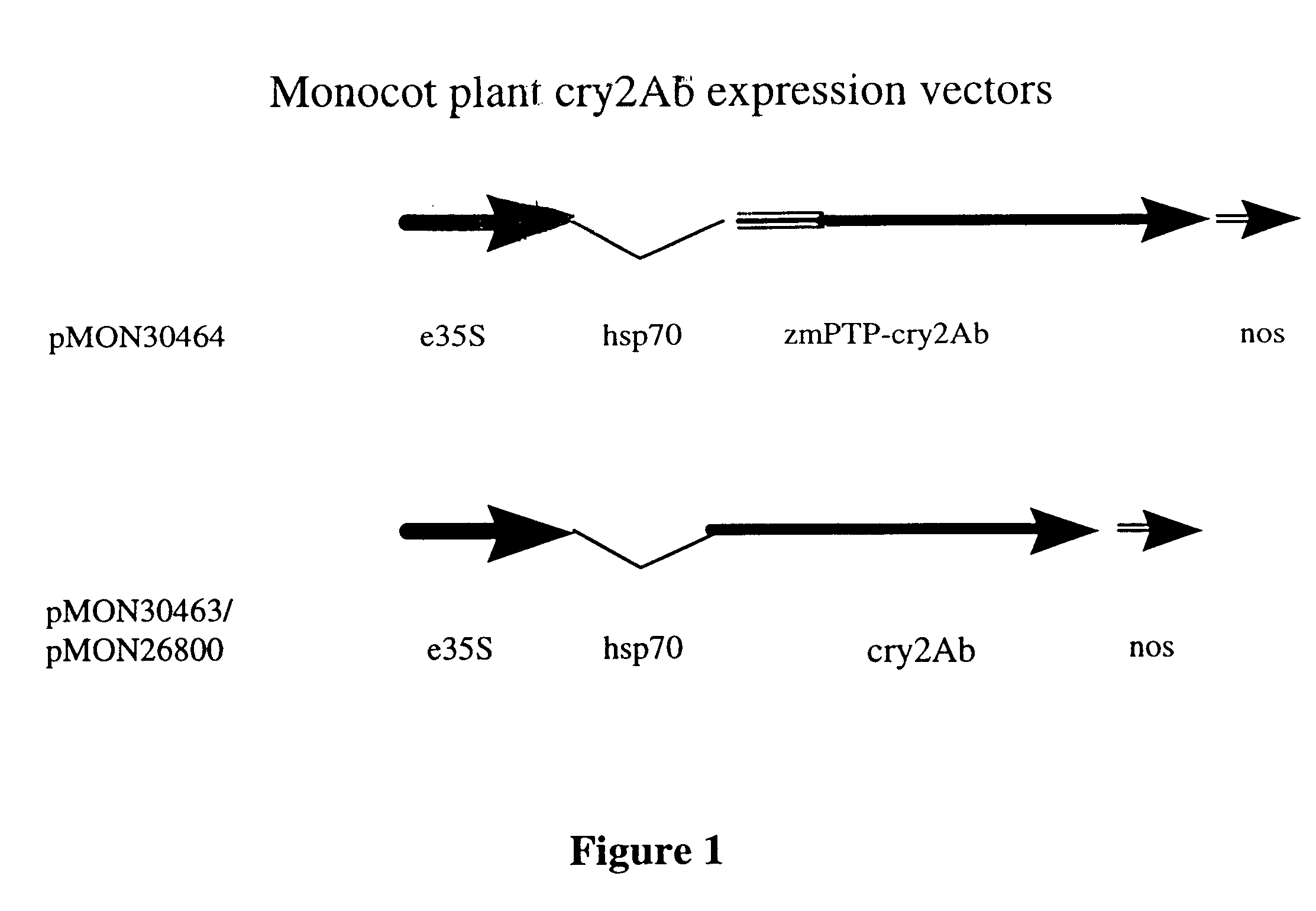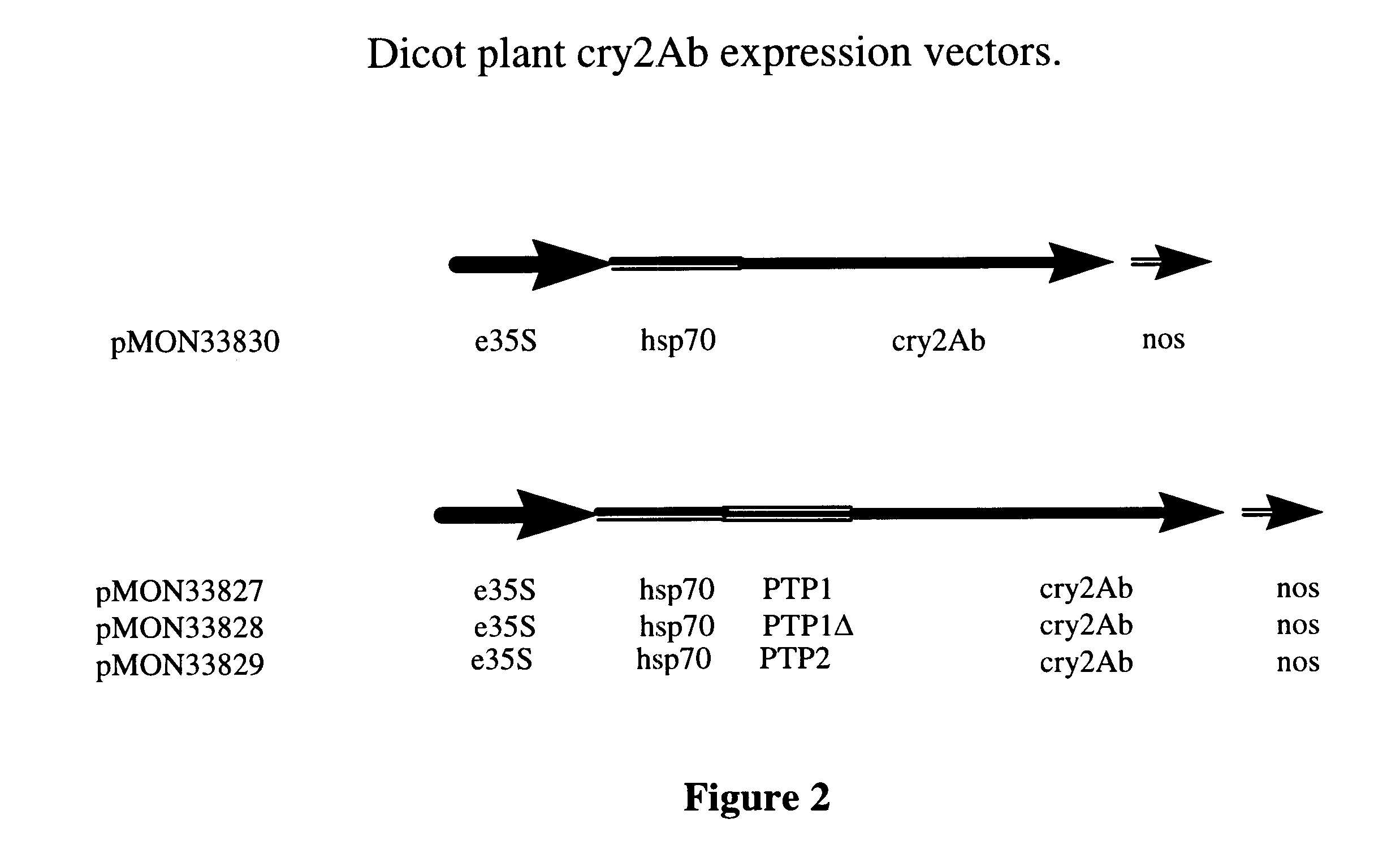Methods for transforming plants to express Cry2Ab delta-endotoxins targeted to the plastids
a technology of deltaendotoxins and plants, applied in the field of transgenic plants, can solve the problems of eventual larvae mortality, osmotic imbalance, lysis of cells lining the midgut epithelium, etc., and achieve the effects of reducing the number of transgenic lines, and increasing the expression of .delta.-endotoxins
- Summary
- Abstract
- Description
- Claims
- Application Information
AI Technical Summary
Benefits of technology
Problems solved by technology
Method used
Image
Examples
example 1
5.1 Example 1
Increased Expression of Cry2Ab by Targeted Vectors
Expression of the Cry2Ab protein in corn plants transformed with targeted and non-targeted Cry2Ab expression vectors was compared and was significantly higher in plants with the targeted vector. Untargeted Cry2Ab plant expression vectors pMON26800 and pMON30463 contain an expression cassette composed of an enhanced CaMV35S promoter, a maize hsp70 intron, a synthetic cry2Ab gene with translational initiation and termination codons (SEQ ID NO:1), and a nopaline synthase polyadenylation site.
The targeted plant expression vector pMON30464 (SEQ ID NO:16) contains an expression cassette including enhanced CaMV35S promoter, a maize hsp70 intron, a maize ssRUBISCO chloroplast transit peptide (SEQ ID NO:3) fused in frame to a synthetic cry2Ab gene, and a nopaline synthase polyadenylation site.
All vectors (pMON26800, pMON30463, and pMON30464) also contain a cassette conferring paromomycin resistance to transformed plant tissue. In...
example 2
5.2 Example 2
Plastid Targeting of Cry2Ab Increases Frequency of Agronomically-Normal Plants Recovered from Transformation
To obtain a commercially viable transgene-based insect control trait, it is crucial that an event with normal plant growth characteristics be obtained. In most instances a fairly large number of independent transgenic events are advanced into field tests to insure that an event that meets all of the key criteria (effective insect control, normal Mendelian behavior of the transgene, and normal growth characteristics or agronomics) will be identified. Methods that increase the frequency with which normal events are obtained are clearly valuable as they increase the odds of identifying an event that can be commercialized. It is also useful to enlarge the pool size of prospective events for screening by increasing the percentage of R.sub.0 events (primary regenerated plants) with fertility. As plant transformation is labor intensive, any method that decreases the numb...
example 3
5.3 Example 3
Plastid Targeting of Cry2Ab Increases Frequency of High Level European Corn Borer Control in Transgenic Corn
The previously described populations of independently transformed events derived from both targeted (pMON30464) and non-targeted (pMON30463 or pMON26800) Cry2Ab expression vectors were also screened for resistance to second generation European corn borer infestations (ECB2). To facilitate these studies, the commercially efficacious transgenic corn event MON810 (Yieldgard.TM.) transformed with the Cry1Ab gene was included as a positive control. Efficacy against ECB2 was tested in field tests essentially as described (Armstrong et al., 1995). In the 1996 field test, 18 independent non-targeted pMON26800 events were compared to MON810 (Cry1Ab). Of these 18 events, only one delivered ECB2 protection that was both statistically indistinguishable from MON810 and significantly less than the non-transgenic negative control (event UT1 in Table 9). In the 1997 field test, 1...
PUM
| Property | Measurement | Unit |
|---|---|---|
| plant morphology | aaaaa | aaaaa |
| frequency | aaaaa | aaaaa |
| nucleic acid sequence | aaaaa | aaaaa |
Abstract
Description
Claims
Application Information
 Login to View More
Login to View More - R&D
- Intellectual Property
- Life Sciences
- Materials
- Tech Scout
- Unparalleled Data Quality
- Higher Quality Content
- 60% Fewer Hallucinations
Browse by: Latest US Patents, China's latest patents, Technical Efficacy Thesaurus, Application Domain, Technology Topic, Popular Technical Reports.
© 2025 PatSnap. All rights reserved.Legal|Privacy policy|Modern Slavery Act Transparency Statement|Sitemap|About US| Contact US: help@patsnap.com



